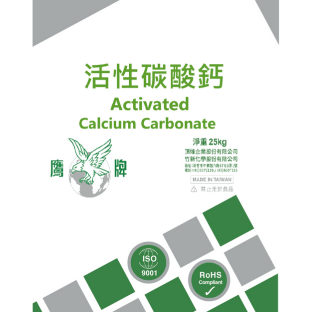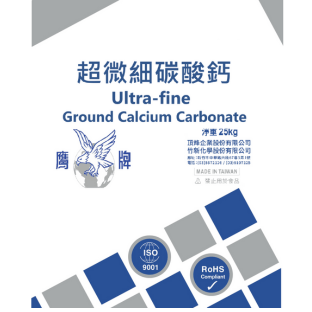

Website Design Copyright 2025 © 竹新化學股份有限公司 & 頂烽企業股份有限公司
All Rights Reserved. 網頁設計 by 覺醒設計
CATALOG
TYPE
Product Categories

Calcium carbonate is a naturally occurring inorganic salt powder and is the most common non-toxic filler used in various industries such as rubber, plastics, papermaking, ink, paint, construction materials, agriculture, and fruit cultivation. Depending on the production process, calcium carbonate can be divided into two main categories. One is produced through a chemical synthesis reaction and subsequent calcination, known as precipitated calcium carbonate, while the other is produced directly through mechanical grinding and is referred to as ground calcium carbonate.
Slide Up
Ground calcium carbonate, depending on different grinding principles during production, results in variations in particle shape and physical properties.
Its particles are primarily irregular in shape, and the differences in fineness and shape lead to variations in apparent density. Currently, there are two main methods for industrial production of ground calcium carbonate: dry process and wet process.
Ground calcium carbonate produced by the dry process is mostly used in industries such as rubber, plastics, and coatings, while production using the wet process is applied in the papermaking industry, with APEX adopting the "dry process production method."
Natural limestone ore → Jaw crusher → Crushing → Grinding mill → Classifier (first classification) → Grinding mill → Classifier (second classification) → Heavy calcium carbonate
For an introduction to our factory facilities ( Please click here)
Ground calcium carbonate can be used as a plasticizer in rubber products to increase the hardness and rigidity of rubber and plastic products.
This is common in the manufacturing of tires, shoe soles, automotive components, PVC fences, wire insulation, and flooring materials.
When used as a filler, ground calcium carbonate can improve the resilience, wear resistance, and tear resistance of rubber products, as well as the hardness, rigidity, and wear resistance of plastic products.
This is useful for producing products like rubber seals, garbage bin wheels, tire treads, garbage bags, containers, pipes, and films.
When employed as a rubber additive, ground calcium carbonate can enhance rubber flowability, improve compounding performance, and reduce heat expansion, aiding in rubber processing and mold release.
Ground calcium carbonate can increase rubber's heat resistance, making the end products more capable of withstanding high-temperature applications, such as automotive engine components.
It can also improve the aging resistance of rubber products, making them more durable.
Used as a heat stabilizer in plastics, ground calcium carbonate helps reduce plastic distortion at high temperatures, which is beneficial for applications like window frames and interior materials.
Ground calcium carbonate provides better color and texture and can replace expensive white pigments.
It is typically used in furniture, home decor, and automotive interiors.
Rubber products filled with heavy calcium carbonate are typically lighter, contributing to reduced fuel consumption and a lower carbon footprint.
Adding calcium carbonate to rubber can reduce raw material costs since calcium carbonate is a relatively inexpensive filler.
Introduction to the Application of Ground Calcium Carbonate in the Rubber Industry (Click Here)
Introduction to the Application of Ground Calcium Carbonate in the Plastic Industry (Click Here)
Calcium carbonate has several significant applications in the paint industry. Here are some primary applications and their effects:
The high surface area of calcium carbonate makes it an ideal filler as it effectively fills paint and coatings, enhancing volume without significantly increasing weight. It extends the lifespan of the paint without adding excessive weight, reducing the need for resins and organic pigments, thereby cutting costs.
Calcium carbonate enhances the paint's ability to cover surfaces, especially when thinner la
Calcium carbonate's hardness and wear resistance augment the surface hardness of paint, making it more durable.
This is crucial in applications requiring long-term durability, such as furniture, flooring, and metal coatings.
It increases the hardness and wear resistance of paints, contributing durability to products like floor coatings, furniture paints, and exterior coatings.
Calcium carbonate ensures even paint coverage, reducing dripping and leaking.
Smaller particle-sized calcium carbonate disperses more readily within paint ba
This enhances paint flow during application.
Additionally, calcium carbonate's relatively high surface area offers more contact points when added to paint. These high surface area structures interact with other components in the paint, reducing intermolecular attraction, thus improving paint flow.
The use of calcium carbonate fillers reduces paint costs as it is relatively inexpensive.
It also decreases the amount of required pigments and other costly ingredients.
Using calcium carbonate reduces the use of harmful substances in paint, lowering the emission of volatile organic compounds (VOCs).
This contributes to environmental protection and enhances paint sustainability.
Introduction to the Application of Calcium Carbonate in the Paint Industry (Click Here)
Calcium carbonate is used to adjust the pH levels in aquaculture ponds or water bodies, ensuring the water maintains appropriate acidity or alkalinity.
This contributes to creating a stable water environment, providing suitable conditions for the growth and metabolism of aquatic organisms, reducing the harmful effects of acidity on aquaculture organisms.
Calcium carbonate enhances water hardness, particularly crucial for freshwater organisms like shrimp and carp.
Adequate hardness helps maintain the health of aquatic organisms.
In aquaculture, calcium carbonate is utilized for implementing biosecurity measures, including regular cleaning and disinfection of aquaculture facilities.
This ensures that the growth environment of aquatic organisms is less susceptible to pathogens.
Proper water quality management and the addition of calcium carbonate help strengthen the immune systems of aquatic organisms, reducing the occurrence of diseases.
Calcium carbonate is used as a structural enhancer for the exoskeletons of aquaculture organisms, especially crustaceans.
This contributes to enhancing the hardness and crush resistance of the exoskeletons, providing better protection for aquatic organisms from damage while facilitating growth and metabolic processes.
Introduction to the Application of Calcium Carbonate in Aquaculture (Click Here)
Calcium carbonate is commonly used as a filler agent added to pulp to enhance the quality and thickness of paper products. This improves paper smoothness, gloss, and print quality.
Calcium carbonate fillers are employed in various paper types such as printing paper, writing paper, packaging paper, and colored paper.
Acid-ba
Maintaining the proper pH aids in the dispersion and stability of fibers in the pulp, thereby enhancing pulp quality and the efficiency of the papermaking process.
Calcium carbonate is used in the surface treatment of specialized papers by adding surface coatings to achieve superior printing performance and glossiness.
These surface coatings provide high-quality printing, vibrant colors, and detailed images in printed materials.
In specific applications, calcium carbonate is employed in coating techniques to enhance paper glossiness and durability.
Coating improves water resistance, stain resistance, durability, and offers superior aesthetics to paper products.
Nano and microparticles of calcium carbonate are widely used in the paper industry to enhance paper's tensile and compressive strength.
This involves uniformly dispersing calcium carbonate nanoparticles in pulp to increase fiber aggregation and structural stability, contributing to enhanced mechanical strength and reduced tearing and breaking of paper.
Calcium carbonate is used to reinforce the multi-la
Calcium carbonate is used in manufacturing processes to establish precise quality control systems that monitor paper density, uniformity, and surface smoothness.
This ensures the consistency of high-quality paper products, meeting stringent standards in printing and packaging industries.
Calcium carbonate is used to finely adjust the surface roughness of paper products.
Controlling the particle size and distribution of calcium carbonate achieves different surface characteristics to meet specific application needs, such as high-resolution printing or special packaging.
Using calcium carbonate as a filler agent reduces the demand for expensive pulp raw materials, lowering production costs.
It also aids in reducing deforestation, thereby enhancing paper sustainability.
Introduction to the Application of Calcium Carbonate in the Paper Industry (Click Here)
We use cookies to collect and analyze information on site performance and usage. By Clicking "Continue" or by clicking into any content on this site, you agree to allow cookies to be placed. To find out more, please visit our privacy policy。
CONTINUE GO TOP
GO TOP




